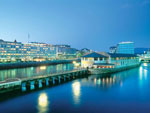 The Bolshoi theatre in Moscow has occupied one of leading places throughout all history of Russian theatrical art. For over two centuries, it has been a main symbol of greatness of Russian culture that has been developing with consideration of internal and external factors, traditions and modern methods, domestic and foreign experience.
The Bolshoi theatre in Moscow has occupied one of leading places throughout all history of Russian theatrical art. For over two centuries, it has been a main symbol of greatness of Russian culture that has been developing with consideration of internal and external factors, traditions and modern methods, domestic and foreign experience.
The establishment of the Bolshoi Theatre dates back to 1776. On 28 March 1776, Empress Catherine II signed and granted the Prince the 'privilege' of organizing theatre performances, masquerades, balls and other forms of entertainment for a period of ten years. The Prince started the construction. The theatre was named the Petrovsky Theatre as it was located in the Petrovka street, but was burnt down before the opening. Urusov passed the right for construction to the co-worker, Englishman Michael Maddoks who built Bosholi Petrovsky Theatre.
However, 25 years afterwards, in 1805 this theatre was also burnt down. Newly reconstructed theatre burnt down in 1812 during Napoleon’s army invasion in Moscow. In 1821 new building was restored and was solemnly opened on 6 January1825 with Celebration of Muses and ballet Sandrilona. The bad luck of theatre continued: on 11 March 1853 the theatre was burnt down again, with only iron carcass and entrance strings left. After large scale preliminary work, only a year later, the Bolshoi Theatre was reopened on 20 August 1856. In 1895 the building underwent its first capital repairs.
Throughout all the 19th century the Bolshoi theatre had the status of imperial theatre, but the status of troupe of the Bolshoi Theatre varied all the time: sometimes it was transferred to the management of the Moscow governor-general, in other times – to the subordination of the Petersburg management. Everything changed after October revolution of 1917 when the Bolshoi Theatre was nationalised.
During the Great World Patriotic War of 1941-1945, the theatre was evacuated to the city of Kuibyshev. Theatre building was hit during one of air raids. The building was restored when the war ended, and performances were restarted. The reconstruction took about ten years and was completed in 1975 by the 200th anniversary of the Bolshoi theatre.
Recently, in 2002, the new stage of the Bolshoi theatre was discovered, since 1 July 2005 its main stage was closed for reconstruction. Its grand opening is scheduled for autumn 2011.
 Today the Bolshoi Theatre theatrical troupe has over 1,000 persons: musicians, dancers, singers, actors, ballet masters, producers, and many others. At the beginning of existence of theatre the troupe of Petrovsky Theatre listed only 13 musicians and 30 actors. There was no any specialization: drama actors sang opera while ballet dancers and singers played in the performances.
Today the Bolshoi Theatre theatrical troupe has over 1,000 persons: musicians, dancers, singers, actors, ballet masters, producers, and many others. At the beginning of existence of theatre the troupe of Petrovsky Theatre listed only 13 musicians and 30 actors. There was no any specialization: drama actors sang opera while ballet dancers and singers played in the performances.
Throughout the whole existence of the Bolshoi Theatre, its many actors, producers and artists were honoured not only with the praises of the audience but also gained recognition of the state : medals, orders and ranks. Perhaps, the Bolshoi theatre can be called a main forge of a theatrical art of Russia. The theatre staged over 800 plays of Russian and foreign classics. Adhering to classical approach to ballet and opera performances, the theatre tries to find something new, makes experiments and finds unusual solutions. Saving traditions, the Bolshoi theatre moves forwards, serving art of the Melpomene.







